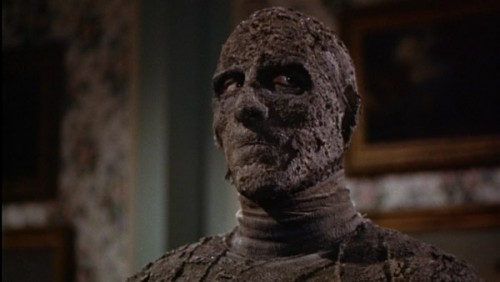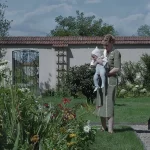Hammer-Rama: The Mummy, by Alexander Miller
The pattern of Hammer’s horror films shadowed Universal’s, as Hammer struck gold over the course of one year (1957-1958) with The Curse of Frankenstein and Horror of Dracula. These films made Hammer Horror the sensation we know it and introduced audiences to the legendary pairing of Christopher Lee and Peter Cushing. Their Dracula and Frankenstein series are what put Hammer on the map, but 1959 is the year that their holy (or unholy) trinity of classic monster remakes came full circle with the inclusion of The Mummy. Universal will always be applauded for their massive contribution to the horror genre, but Hammer’s revisionist titles exceed Universal’s in my opinion simply because they’re more exciting.
Dracula and Frankenstein are more commercially viable as traditional Victorian horror, whereas The Mummy is somewhat relegated to second tier status. That might be the consensus to some, but to the crew at Hammer they played this one straight, and the result was another gem from their golden era. The Mummy, one of Hammer’s best looking films, also firmly established the screen chemistry of its stars Lee and Cushing, but most importantly it boasts first class direction from genre stalwart Terence Fisher. Hammer’s Rolodex of standout directors consisted of Roy Ward Baker, Seth Holt, Freddie Francis, and Val Guest, but Terence Fisher is easily the best director to have worked for small studio. Naturally, powerhouse screenwriter Jimmy Sangster penned a script to see if lightning would strike a third time with The Mummy, and thrice it struck.
The story here is relatively simple; archeologists disturb the sacred tombs of priest Kharis (Lee) and by the will of the gods Kharis comes to life and lurches his way to avenge those responsible. When will people learn? Familiarity aside, The Mummy is enlivened with a rousing pace thanks to a writer-director team honing Hammer’s collective tradition of quality. Mutual inspiration was also commonplace in front of the camera; Yvonne Furneaux (fresh off the international success of Fellini’s classic La Dolce Vita) provides more than just a few screams to the story. Her chemistry with Lee is fascinating as a woman who resembles a reincarnation of Princess Ananka thus quelling the titular monster.
Peter Cushing is his energetic self and is (as always) entertaining as a fast-talking, quick-witted, physically adept and ever-so-mannered archeologist. Thanks to the bizarre poster art that showed a beam of light shining through the mummy’s torso, Cushing suggested they “mustn’t cheat the audience…could I take the harpoon from the study and run it right through dear old Christopher?” Stories like this show the camaraderie and collaborative effort that, in this case, lead to one of the best scenes in the film, in which Cushing battles the undead creature. Aside from the hour-and-a-half prep time for Lee’s makeup, he fearlessly crashed through windows, and doors at one point nearly dislocating his shoulder when he plowed into a stunt door that was locked. Despite all the damage dealt towards the debonair actor, it doesn’t slow Kharis down, proving once again that the stately Christopher Lee is an incomparable monster.
Sets by Bernard Robinson make this modest project look as if it were multi-million dollar picture, the catacombs of Kharis and Ananka are brought to life on the much utilized Bray Studio. Cinematographer Jack Asher’s saturated technicolor palette accentuates the lush yellows and blues of Egyptian decor; the images just pop out at you. Fisher, favoring a more moody atmosphere after the more gore forward (for the time) approach in The Curse of Frankenstein and Horror of Dracula pays off handsomely, even if the brass at the British Board of Film Censors didn’t exactly approve. It seemed like Fisher’s illusory direction of implied macabre worked a bit too well since censors and critics once again lambasted Hammer for the suggested violence that they were so good at circumnavigating this time around.
Hammer’s saber rattling with the board of censors is something of a subject in itself. Ironically, when The Mummy was first screened, the BBFC gave Hammer’s latest monster movie an A certificate, meaning it would reach more screens (ergo being more profitable). When the color version played, however, it received an X certificate. John Trevelyan, head of the BBFC, protested the opening scene when Lee’s character Kharis get his tongue cut out. It wasn’t so much the act of mutilation, but the following scene that shows the severed piece of flesh being held up. Still images of this can be found (as it was left in the Japanese print), but these violent images had to be removed. Hammer’s relationship with the censors led to some selective editing for foreign distribution. Japanese cuts featured more blood, and versions for other European countries had a bit more skin. Regardless of the X rating, The Mummy was more of a success than Horror of Dracula. Hammer now had carte blanche with Universal’s collection of monsters. The sky seemed like the limit.
The Mummy doesn’t enjoy the recognition or prestige The Curse of Frankenstein or Horror of Dracula do, but it’s still one of the studio’s best-looking and most entertaining efforts, considered by many as one of their finest. These three films could be tethered as an informal trilogy, since they shaped Hammer horror, kicking off the studios three most enduring franchises, all helmed by Fisher and starring Lee and Cushing. Terence Fisher didn’t return to Hammer’s Mummy films, and its sequels consequently vary in quality. Suffice it to say, this one is the best, but we’ll hear more about the others later on.





























